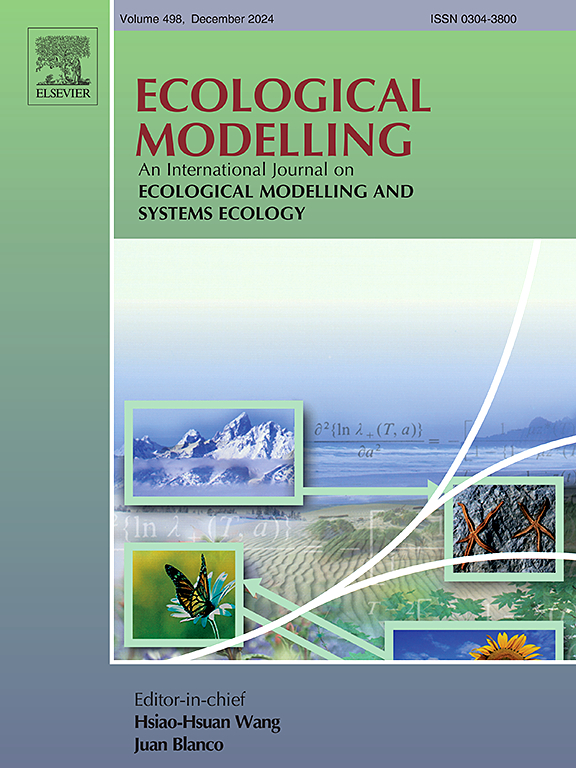Stochastic disturbances and delays drive coexistence and extinction in competing populations
IF 2.6
3区 环境科学与生态学
Q2 ECOLOGY
引用次数: 0
Abstract
The coexistence and extinction of competing populations are influenced not only by primary competing species but also by environmental stochastic disturbances, time delays, and secondary competing species. Based on the Lotka-Volterra model, this study establishes a stochastic population competition model with S-type distributed delays, incorporating the influence factor q of secondary species and the environment. Intrinsic and interspecific disturbances are represented using Ornstein-Uhlenbeck processes and white noise. Theoretical analysis and numerical simulations were conducted as follows: (1) A Lyapunov function was constructed to prove the existence and uniqueness of the global positive solution of the model, and conditions for global asymptotic stability were derived based on Markov semigroup theory. (2) Under low-intensity stochastic disturbances, the population with stronger competitiveness increased in size, while the weaker population tended toward extinction. When there was no difference in competitive strength, both populations could coexist in the long term; Under medium-intensity disturbances, coexistence and extinction exhibited complex patterns; Under high-intensity disturbances, randomness became the dominant factor, leading to rapid population declines, abnormal fluctuations, and eventual extinction. Nevertheless, competitiveness and time delays further complicated population dynamics; Time delays alleviated population fluctuations and promoted system stability under low-intensity disturbances. However, under higher disturbances, they initially amplified fluctuations and introduced periodic dynamics but ultimately helped stabilize the system; The influence factor q moderated population fluctuations and improved the survival conditions of weaker populations under low-intensity disturbances but showed diminished effects under medium- and high-intensity disturbances. This study enhances the understanding of coexistence and extinction mechanisms in competing populations, offering significant insights into ecosystem management and conservation strategies.
随机干扰和延迟驱动竞争种群的共存和灭绝
竞争种群的共存和灭绝不仅受到主要竞争物种的影响,还受到环境随机干扰、时间延迟和次要竞争物种的影响。在Lotka-Volterra模型的基础上,考虑次生物种和环境的影响因子q,建立了具有s型分布时滞的随机种群竞争模型。用Ornstein-Uhlenbeck过程和白噪声表示固有的和种间的扰动。理论分析和数值模拟结果如下:(1)构造Lyapunov函数证明了模型整体正解的存在唯一性,并基于Markov半群理论推导了全局渐近稳定的条件。(2)在低强度随机干扰下,竞争能力较强的种群规模增大,竞争能力较弱的种群规模趋于灭绝。当竞争强度不存在差异时,两个种群可以长期共存;在中等强度扰动下,共存与灭绝表现出复杂的模式;在高强度干扰下,随机性成为主导因素,导致种群数量快速下降,异常波动,最终灭绝。然而,竞争和时间延迟使人口动态进一步复杂化;时滞缓解了种群波动,促进了系统在低强度扰动下的稳定性。然而,在更高的扰动下,它们最初放大了波动并引入了周期动力学,但最终有助于稳定系统;影响因子q在低强度干扰下调节种群波动,改善弱种群的生存条件,但在中、高强度干扰下作用减弱。该研究增强了对竞争种群共存和灭绝机制的理解,为生态系统管理和保护策略提供了重要的见解。
本文章由计算机程序翻译,如有差异,请以英文原文为准。
求助全文
约1分钟内获得全文
求助全文
来源期刊

Ecological Modelling
环境科学-生态学
CiteScore
5.60
自引率
6.50%
发文量
259
审稿时长
69 days
期刊介绍:
The journal is concerned with the use of mathematical models and systems analysis for the description of ecological processes and for the sustainable management of resources. Human activity and well-being are dependent on and integrated with the functioning of ecosystems and the services they provide. We aim to understand these basic ecosystem functions using mathematical and conceptual modelling, systems analysis, thermodynamics, computer simulations, and ecological theory. This leads to a preference for process-based models embedded in theory with explicit causative agents as opposed to strictly statistical or correlative descriptions. These modelling methods can be applied to a wide spectrum of issues ranging from basic ecology to human ecology to socio-ecological systems. The journal welcomes research articles, short communications, review articles, letters to the editor, book reviews, and other communications. The journal also supports the activities of the [International Society of Ecological Modelling (ISEM)](http://www.isemna.org/).
 求助内容:
求助内容: 应助结果提醒方式:
应助结果提醒方式:


